The Zymoglyphic Museum has been targeted by the Museum of Dust for a hostile takeover. We recognize that due to staffing shortages the Zymoglyphic Museum's cleanliness may not be up to snuff (and noting that some staff believe that the accumulated dust enhances, rather than detracts from, the exhibits, by lending them a certain air of authenticity and credbility), and that the museum does indeed have a high concentration of desirable rust and decay, and further that the museum, as with all things, must eventually return to dust. Still, we had not expected it to come so soon. The museum's board is meeting even now to assess the threat.
The facts we have so far are these: The Museum of Dust's director goes by the highly suspicious name of Incognita Nom de Plume, or some variation thereof, and has an implausibly long personal history, involving an arachnoid accomplice (who sounds dangerous) and a mysterious entity called "Musrum" whose museum seems destined to suffer a fate similar to our own. We suspect this cabal may be associated with the equally shadowy Athanasius Kircher "Society", of which Kircher himself is the recording secretary and apparently its only member. Kircher had his own museum in Rome over 300 years ago (reduced to dust by now), and had not been heard from since then until he entered the modern age by becoming, like so many others, a blogger.
We will be sifting through the evidence for further clues.
-- Museum Staff
Sunday, June 25, 2006
Saturday, June 17, 2006
Andy Goldsworthy's Collaborations with Nature
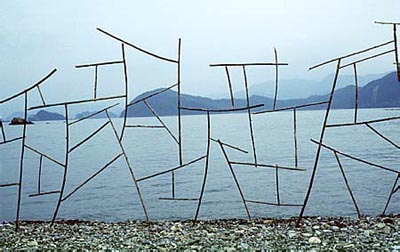 As I noted last week, in David Attenborough's documentaries, the natural world is teeming, bizarre place of baroque mating rituals, predation, and survival. A more bucolic view of nature is one that looks at the beauty in natural forms and patterns. One of the themes in Zymoglyphic culture is making art from natural objects, often with minimal transformation. Andy Goldsworthy is the purest Western practitioner of the craft of arranging natural materials into art forms. Usually, it is a matter of lightly imposing some human abstraction - a circle, spiral, or an unnatural crack - in a natural landscape to somehow achieve a magical effect. Some of his creations are permanent installations in stone, but most are ephemeral structures of ice, leaves, water, sticks or the crackles in drying mud. For these, his photographs become the final creative product and only remaining evidence of the work. The photographs in turn are available in a series of high-quality books. A good survey is Andy Goldsworthy: A Collaboration with Nature
As I noted last week, in David Attenborough's documentaries, the natural world is teeming, bizarre place of baroque mating rituals, predation, and survival. A more bucolic view of nature is one that looks at the beauty in natural forms and patterns. One of the themes in Zymoglyphic culture is making art from natural objects, often with minimal transformation. Andy Goldsworthy is the purest Western practitioner of the craft of arranging natural materials into art forms. Usually, it is a matter of lightly imposing some human abstraction - a circle, spiral, or an unnatural crack - in a natural landscape to somehow achieve a magical effect. Some of his creations are permanent installations in stone, but most are ephemeral structures of ice, leaves, water, sticks or the crackles in drying mud. For these, his photographs become the final creative product and only remaining evidence of the work. The photographs in turn are available in a series of high-quality books. A good survey is Andy Goldsworthy: A Collaboration with Nature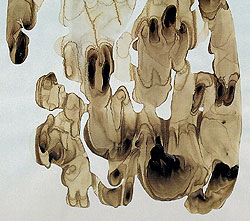 A lesser-known type of work that he does are "snowball paintings", which are created by putting a snowball stained with a natural dye on paper and letting it melt. The result is an amazingly detailed pattern created by the way the dye is deposited as the snow melts and the water evaporates. A detail from one is shown here, with an enlargement here. The Zymoglyphic acrylic paintings achieve a similar effect from the deposition patterns of the (unnatural) acrylic pigment.
A lesser-known type of work that he does are "snowball paintings", which are created by putting a snowball stained with a natural dye on paper and letting it melt. The result is an amazingly detailed pattern created by the way the dye is deposited as the snow melts and the water evaporates. A detail from one is shown here, with an enlargement here. The Zymoglyphic acrylic paintings achieve a similar effect from the deposition patterns of the (unnatural) acrylic pigment. An additional dimension to Goldsworthy's work is provided in the excellent documentary Rivers & Tides
He has two permanent installations in the Bay Area. One is Stone River in front of the Cantor Arts Center on the Stanford University campus, and the other
is at the de Young Museum in Golden Gate Park.
Sunday, June 11, 2006
Life in the Undergrowth
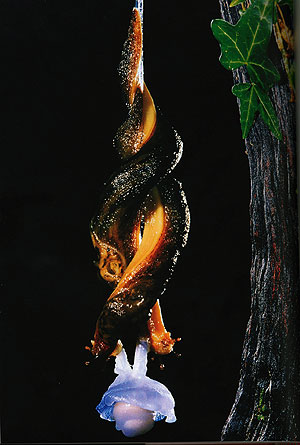
In the Alice books, Lewis Carroll presents reality as pretty boring compared to the world of imagination and dreams. The dreams, of course, may turn out to be rather nightmarish. David Attenborough makes nature documentaries which advance the thesis that the natural world is actually truly amazing if you get down and take a look at it. His latest series, Life in the Undergrowth
There is a nice book
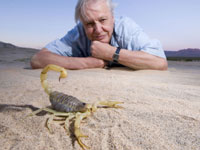 David Attenborough would make an excellent guide to the Zymoglyphic regions as well. He has great qualifications - he had a little museum when he was a boy, and now has huge collection of souvenirs from his travels. He is a perfect mixture of authoritativeness, enthusiasm, wonder, and a taste for the bizarre. A phrase he often uses is "and the strangest of all is this one...". He combines all that with the latest technical wizardry in closeup photography and has an engaging personal style. He is always on the scene, often windblown or out of breath, battling mosquitos to sneak up on some hapless creature. He keeps up with recent discoveries, so each series often includes some new odd animal, plant, or behavior that I have not heard about. He has covered a full range of biological and anthropological themes, and he has managed to contribute to science without having to specialize. He always has interesting ideas on the interconnectedness of things; not just describing some odd behavior, but explaining what forces have caused it to evolve that way. If he is not available for the job (as is likely), he can still serve as a role model!
David Attenborough would make an excellent guide to the Zymoglyphic regions as well. He has great qualifications - he had a little museum when he was a boy, and now has huge collection of souvenirs from his travels. He is a perfect mixture of authoritativeness, enthusiasm, wonder, and a taste for the bizarre. A phrase he often uses is "and the strangest of all is this one...". He combines all that with the latest technical wizardry in closeup photography and has an engaging personal style. He is always on the scene, often windblown or out of breath, battling mosquitos to sneak up on some hapless creature. He keeps up with recent discoveries, so each series often includes some new odd animal, plant, or behavior that I have not heard about. He has covered a full range of biological and anthropological themes, and he has managed to contribute to science without having to specialize. He always has interesting ideas on the interconnectedness of things; not just describing some odd behavior, but explaining what forces have caused it to evolve that way. If he is not available for the job (as is likely), he can still serve as a role model!
Saturday, June 03, 2006
Alice and Me in Wonderland
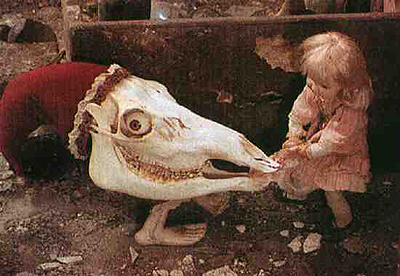
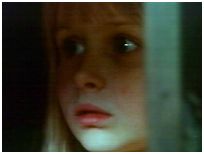
I must have seen the Disney version of Alice in Wonderland
In high school I discovered Martin Gardner's The Annotated Alice
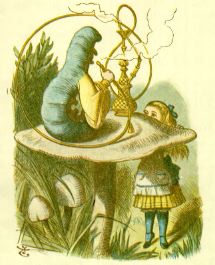
I was quite tickled when the Jefferson Airplane had a hit with White Rabbit, since it was based on what I was then seeing as an rather intellectual exercise. In college, the Disney film was in heavy rotation at campus film fests. Alice, her mushrooms, and the "hookah-smoking caterpillar" had now become psychedelic icons, the rabbit hole a gateway to an alternate reality. Like Carroll, I was equally fascinated by math and logic, and by the free form view of reality that nonsense provided.
This whole reminiscence of Alice started when I watched Jan Svankmajer's film, Alice
For more about this film, see here (video clips), here (part of a large Alice site) and here (detailed commentary)
Subscribe to:
Posts (Atom)